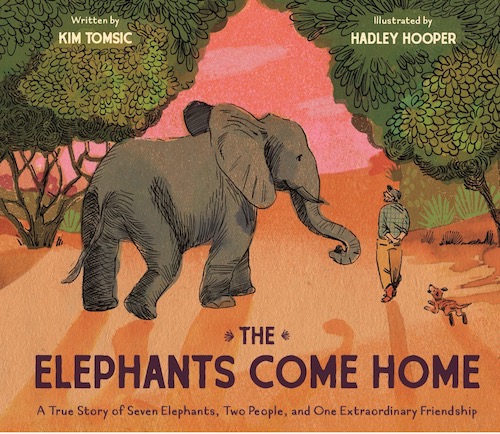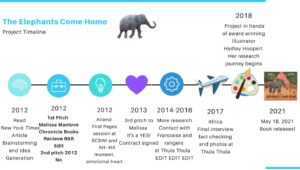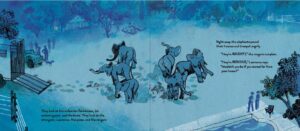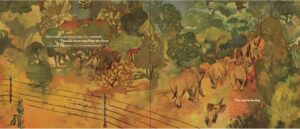
Chronicle Books | 978-1452127835
About a month ago, Kim Tomsic and I were (finally!) able to schedule our first lunch together in over a year. We’d both been vaccinated and had a lot of catching up to do. Kim’s newest book, THE ELEPHANTS COME HOME, was publishing in May, and I was anxious to learn more. As we sat and talked, Kim shared the remarkable story of the seven elephants of Thula Thula – a private game reserve in Zululand, South Africa – who had been welcomed and cared for by Lawrence and Françoise Malby-Anthony.
This was no run-of-the-mill animal rescue story. This was a story about connection and friendship, love and mutual respect. An extraordinary reminder of the interconnectedness of our world and a story that readers of all ages would find hopeful, heartwarming, and inspiring.
I was thrilled when Kim agreed to a short interview. Writers will be encouraged by Kim’s perserverance. Students and teachers will learn more about the process of following a story, finding the heart, and working through multiple revisions until the writing is polished and ready for a reader’s eye.
Dianne: Welcome to ReaderKidZ, Kim! I’m excited to share your newest book, THE ELEPHANTS COME HOME: A True Story of Seven Elephants, Two People, and One Extraordinary Friendship (gorgeously illustrated by Hadley Hooper) with our readers.
You carried this story for a number of years. Those who aren’t writers don’t often understand that even a picture book, as short as it can sometimes be, takes time to germinate and find its way to the “just right” words. Can you talk a little about the timeline and your process as you began to dig into the “story behind the story,” the research, the drafts, and, finally, the published book?
Kim: Hi, Dianne! Thank you so much for inviting me for this interview.
THE ELEPHANTS COME HOME has been my passion project for nine years. I first learned of these seemingly magical elephants in March 2012. The New York Times had posted an article about Lawrence Anthony and the amazing herd at his wildlife sanctuary, Thula Thula, which is located in Zululand, South Africa. The connection he had with the herd seemed supernatural to me—for example, every time he returned home from a business trip, somehow the herd knew when his flight landed, and they would meet him at the gate upon his arrival. Naturally, I had to know more.
I began my research journey by reading The Elephant Whisperer by Lawrence Anthony and Graham Spence (read it—you’ll thank me later!). Then I dug up as many articles about these elephants and the people behind them as I could find. I learned that the elephants had been hunted and then displaced from one home to the next until they finally came to Thula Thula. They were scared and angry when they arrived, and they did not trust humans. The more I researched, the more I wanted to know. I watched documentaries and YouTube videos on Lawrence and Françoise Anthony, and I uncovered articles here and there. After a respectful amount of time and research had been given to the project, I reached out to Françoise. She was immensely helpful. Ahhhh, so that brings me to the timeline. Here it is in a snapshot!

CLICK TO ENLARGE!
Dianne: In your recent (virtual) book launch, you mentioned that your editor, Melissa Manlove of Chronicle Books, asked the question, “Where’s the placeholder for the child’s emotions?” What did you understand her to mean, and what was your process for finding the emotional center of this beautiful story?
Kim: I initially pitched this story to Melissa with a bunch of fascinating details and also (ugh) several subordinate clauses. In case you’re like me, I had to look up “subordinate clauses”—come to find out, it’s a clause that cannot stand alone as an independent sentence, i.e. “When so-and-so drank the potion, she sprouted wings and flew.” As you can see, “When so-and-so drank the potion” is a fragment by itself—it’s a clause subordinate to “she sprouted wings and flew.” Melissa explained that subordinate clauses are hard for the picture book audience (usually a young age group) and also that something else was missing from my story. Essentially, she gave me a revise and resubmit.
I revised my sentence structures and word choices, but I still didn’t know what the elusive missing “something” was. Melissa rejected the revision, and I knew she was right—fascinating details do not a book make.
Later that same year, I attended a “first pages” session at an SCBWI conference (first-pages sessions include a team of agents and editors who read the first page of a manuscript out loud to an audience and then unabashedly give their first impressions and the whys behind their statements). I did not have a page submitted. But in the gift of listening to the publishing genius in front of me, I had my ah-ha moment— The elephants would be the placeholder for the child’s emotions. They would carry the emotions of the child reader, meaning: this is where the reader would insert themselves into the story. Once the child had a place, they would be able to pick up and follow the treasure map to the heart of the story.
CLICK TO ENLARGE Illustrations © Hadley Hooper
Dianne: Ah, yes! I see! Your original drafts were missing an entry point for the child reader. And the elephants became that stand-in for a child reader. Thanks for clarifying that!
The language, the pacing, the way you have carefully crafted the repetition of certain phrases like: “The elephants come…”, “ … live with you by day and camp with you by night by night… stay with you and you will not be alone.” The whole book is such a beautiful example of the Samuel Taylor Coleridge quote I often refer to when talking about how picture books are like poetry – that is, they should use only the “best words, in their best order.”
Kim: Thank you for appreciating these nuances, Dianne. Right back at you—I love the lyrical beauty you deliver in your picture books. Short picture books seem deceptively easy, yet we writers spend hours turning over single sentences. We toil over word choice. We think about sonic resonance. Everything matters and it should. Our readers deserve the best words in their best order.
CLICK TO ENLARGE © Illustrations by Hadley Hooper
Dianne: What’s up next? Can you share with readers what you’re working on now and what we can look forward to?
Kim: Next up, THE TRUTH ABOUT 5TH GRADE (HarperCollins, 2023) by me and co-writer Mark Parisi. It’s a he-said/she-said diary telling of “true” about fifth-grade friendships, pranks, and drama illustrated a-la Wimpy Kid style by comic genius Mark Parisi. If you want a peek at Mark’s art, check out OffTheMark.com which is an award-winning daily newspaper comic.
Dianne: Oh! That’s sound fabulous. We’ll be looking for that in 2023. Thanks, again, Kim for sharing THE ELEPHANTS COME HOME with readers!
- For more about Kim, you can visit her website HERE.
- Learn more about illustrator Hadley Hooper HERE.












